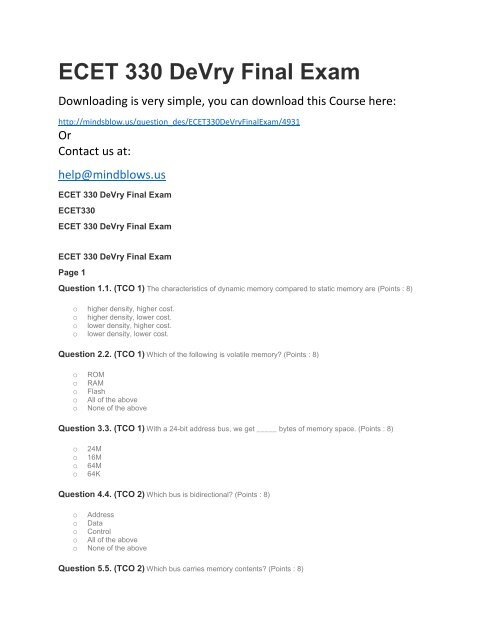ECET 330 DeVry Final Exam
You also want an ePaper? Increase the reach of your titles
YUMPU automatically turns print PDFs into web optimized ePapers that Google loves.
<strong>ECET</strong> <strong>330</strong> <strong>DeVry</strong> <strong>Final</strong> <strong>Exam</strong><br />
Downloading is very simple, you can download this Course here:<br />
http://mindsblow.us/question_des/<strong>ECET</strong><strong>330</strong><strong>DeVry</strong><strong>Final</strong><strong>Exam</strong>/4931<br />
Or<br />
Contact us at:<br />
help@mindblows.us<br />
<strong>ECET</strong> <strong>330</strong> <strong>DeVry</strong> <strong>Final</strong> <strong>Exam</strong><br />
<strong>ECET</strong><strong>330</strong><br />
<strong>ECET</strong> <strong>330</strong> <strong>DeVry</strong> <strong>Final</strong> <strong>Exam</strong><br />
<strong>ECET</strong> <strong>330</strong> <strong>DeVry</strong> <strong>Final</strong> <strong>Exam</strong><br />
Page 1<br />
Question 1.1. (TCO 1) The characteristics of dynamic memory compared to static memory are (Points : 8)<br />
o<br />
o<br />
o<br />
o<br />
higher density, higher cost.<br />
higher density, lower cost.<br />
lower density, higher cost.<br />
lower density, lower cost.<br />
Question 2.2. (TCO 1) Which of the following is volatile memory? (Points : 8)<br />
o<br />
o<br />
o<br />
o<br />
o<br />
ROM<br />
RAM<br />
Flash<br />
All of the above<br />
None of the above<br />
Question 3.3. (TCO 1) With a 24-bit address bus, we get _____ bytes of memory space. (Points : 8)<br />
o<br />
o<br />
o<br />
o<br />
24M<br />
16M<br />
64M<br />
64K<br />
Question 4.4. (TCO 2) Which bus is bidirectional? (Points : 8)<br />
o<br />
o<br />
o<br />
o<br />
o<br />
Address<br />
Data<br />
Control<br />
All of the above<br />
None of the above<br />
Question 5.5. (TCO 2) Which bus carries memory contents? (Points : 8)
o<br />
o<br />
o<br />
o<br />
Data bus<br />
Address bus<br />
Control bus<br />
None of the above<br />
Question 6.6. (TCO 2) The address bus is __________. (Points : 8)<br />
o<br />
o<br />
o<br />
o<br />
bidirectional<br />
unidirectional<br />
able to be programmed to be either bidirectional or unidirectional<br />
None of the above<br />
Question 7.7. (TCO 3) To use JSR (or CALL) instruction, we must initialize _____ register. (Points : 8)<br />
o<br />
o<br />
o<br />
o<br />
X<br />
Y<br />
PC<br />
SP<br />
Question 8.8. (TCO 3) Find the value of Register A for the following program.<br />
LDAA #$55<br />
EORA #$AA (Points : 8)<br />
o A = $00<br />
o A = $FF<br />
o A = $7F<br />
o None<br />
Question 9.9. (TCO 3) The dollar sign ($) that precedes numbers in MC9S12 assembly language means that<br />
(Points : 8)<br />
o<br />
o<br />
o<br />
o<br />
o<br />
it is a hexadecimal number.<br />
it is a decimal number.<br />
it is immediate mode.<br />
All of the above<br />
None of the above<br />
Question 10.10. (TCO 3) The largest value (in hex) that can be loaded into Register A of HCS12 is (Points : 8)<br />
o $08.<br />
o $255.<br />
o $65535.<br />
o $FF.<br />
Page 2<br />
Question 1.1.(TCO 4) What addressing mode is used for the instruction, INX? (Points : 8)<br />
o<br />
o<br />
o<br />
o<br />
o<br />
Direct<br />
Indexed<br />
Inherent<br />
Immediate<br />
None of the above<br />
Question 2.2.(TCO 5) When instruction, “jsr”, is executed, the return address is stored at (Points : 8)
o<br />
o<br />
o<br />
o<br />
PC.<br />
CCR.<br />
SP.<br />
memory pointed by SP.<br />
Question 3.3.(TCO 5) After the execution of the following code, the value in Register D is:<br />
LDAA #$BB<br />
LDAB #$CC<br />
ANDA #$0F<br />
ANDB #$F0 (Points : 8)<br />
o<br />
o<br />
o<br />
o<br />
o<br />
$FFFF.<br />
$CCBB.<br />
$C00B.<br />
$0BC0.<br />
None of the above<br />
Question 4.4.(TCO 5) Which bit is used to indicate the sign of a 16-bit signed number? (Points : 8)<br />
o<br />
o<br />
o<br />
o<br />
D0<br />
D15<br />
D7<br />
D1<br />
Question 5.5.(TCO 5) In the following program, the maximum number of iterations is limited to _________.<br />
L1 CLRA<br />
NOP<br />
NOP<br />
DECB<br />
BNE L1 (Points : 8)<br />
o 255<br />
o 100<br />
o 0x200<br />
o 0x99<br />
Question 6.6.(TCO 7) What C-language construct does the following assembly code implement? cmpb #10 bpl<br />
ADD37H addb #$30 bra CONT ADD37H: addb #$37 CONT: stab 0,x (Points : 8)<br />
o<br />
o<br />
o<br />
o<br />
o<br />
Loop<br />
If<br />
If /else<br />
All of the above<br />
None of the above<br />
Question 7.7.(TCO 8) Assume that PORTB has a value of 0x37. Which of the following gives us unpacked BCD<br />
for 7? (Points : 8)<br />
o PORTB = PORTB & 0x37;<br />
o PORTB = PORTB | 0x30;<br />
o PORTB = PORTB | 0x0F;
o<br />
PORTB = PORTB & 0x0F;<br />
Question 8.8.(TCO 8) The following program creates square wave pulses on PB0. What is the duty cycle?<br />
ORG $8000 LDS #$4000 LDAA #$FF STAA DDRB BACK BSET PORTB,%00000001 JSR DELAY JSR DELAY BCLR<br />
PORTB,%00000001 JSR DELAY JSR DELAY BRA BACK (Points : 8)<br />
o 75%<br />
o 66%<br />
o 50%<br />
o 25%<br />
Question 9.9.(TCO 8) Find the value for PORTB after the execution of the following code: PORTB = 0x55 ^ 0xFF;<br />
(Points : 8)<br />
o<br />
o<br />
o<br />
o<br />
PORTB = 0x05<br />
PORTB = 0x0A<br />
PORTB = 0xAA<br />
PORTB = 0xFF<br />
Question 10.10.(TCO 8) Fill in the blank to get 0x38 on PORTB. unsigned char BCD_Byte = 0x89; unsigned char<br />
x; x = BCD_Byte & 0xF0; _____; PORTB = x | 0x30; (Points : 8)<br />
o<br />
o<br />
o<br />
o<br />
x=x>>4;<br />
x=x>>2;<br />
x=x

















